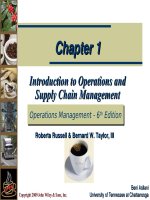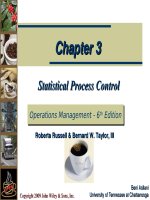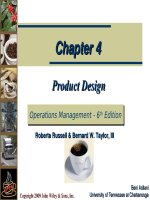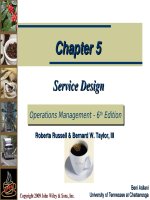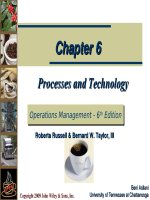Enterprise systems for management 2nd by motiwalla and thompson chapter 01
Bạn đang xem bản rút gọn của tài liệu. Xem và tải ngay bản đầy đủ của tài liệu tại đây (836.93 KB, 51 trang )
CHAPTER 1
Introduction to
Enterprise Systems for
Management
1 Copyright © 2012 Pearson Education, Inc. Publishing as Prentice Hall
Learning Objectives
•
•
•
•
Understand the information systems evolution and its historical role in the
organization leading to systems integration and Enterprise Resource Planning
(ERP).
Learn about ERP systems and evolution, components, and architecture;
understand the benefits and drawbacks of implementing ERP systems and
how they can help an organization improve its efficiency and worker
productivity.
Gain an overview of the implementation process (e.g., the ERP life cycle,
business process reengineering project management, and change
management). Understand the role of people, vendors, consultants, and the
organization in making the ERP implementation process successful.
Comprehend the ethical, global, and security challenges while implementing
an ERP system, and look at the ERP vendors and industry trends.
2 Copyright © 2012 Pearson Education, Inc. Publishing as Prentice Hall
Preview
•
In the early days of ERP implementation most management did not understand
the magnitude of issues an organization has to consider before, during, and
after implementation.
•
ERP systems are very different from conventional packaged software, such as
Microsoft Office and others.
•
There are no shortcuts when it comes to implementing an enterprise system.
3 Copyright © 2012 Pearson Education, Inc. Publishing as Prentice Hall
Enterprise Systems in Organizations
•
Business organizations have become very complex and their business needs
can no longer be supported by one single information system.
•
Information Systems are a critical component of a successful organization
today.
•
Management is generally categorized into three levels: Strategic, MidManagement and Operational.
•
Information Systems provide a high level of computer automation to support
business functions such as:
•Accounting
•Finance
•Human Resource Management
•Customer Service
•Marketing
•Operations
4 Copyright © 2012 Pearson Education, Inc. Publishing as Prentice Hall
Figure 1-1 Management Pyramid with Information
Requirements
5 Copyright © 2012 Pearson Education, Inc. Publishing as Prentice Hall
Information Silos and Systems Integration
•
Over time, Information Systems create a hodgepodge of independent
nonintegrated systems ultimately creating bottlenecks and interfering with
productivity.
•
Organizations need to be agile and flexible and will require their information
systems to have integrated data, applications, and resources from across the
organization.
•
To compete effectively, organizations have to be customer focused.
– This requires cross-functional integration among the
accounting, marketing and other departments of the
organization.
6 Copyright © 2012 Pearson Education, Inc. Publishing as Prentice Hall
Enterprise Resource Planning (ERP) Systems
WHAT IS AN ERP SYSTEM?
•
Enterprise Resource Planning Systems are the first generation of enterprise
systems meant to integrate data and support all the major functions of
organizations.
•
ERP systems integrate various functional aspects of the organization as well
as systems within the organization of its partners and suppliers.
•
The goal of an ERP system is to make the information flow dynamic and
immediate, therefore, increasing its usefulness and value.
7 Copyright © 2012 Pearson Education, Inc. Publishing as Prentice Hall
Figure 1-2 Integrated Systems - ERP
8 Copyright © 2012 Pearson Education, Inc. Publishing as Prentice Hall
Enterprise Resource Planning (ERP) Systems (Cont’d)
•
Another goal of ERP is to integrate departments and functions across an
organization into a single infrastructure that serves the needs of each
department.
•
ERP systems replace an assortment of systems that typically existed in
organizations. (Accounting, HR, Materials Planning, Transaction Processing,
etc.).
•
ERP solves the critical problem of integrating information from different
sources and makes it available in real-time.
9 Copyright © 2012 Pearson Education, Inc. Publishing as Prentice Hall
Evolution of ERP
Timeline
System
Platform
1960s
Inventory Management
& Control
Mainframe legacy systems using third
generation software-(Cobol, Fortran)
1970s
Materials Requirements Mainframe legacy systems using third
Planning (MRP)
generation software-(Cobol, Fortran)
1980s
Materials Requirements Mainframe legacy systems using fourth
Planning (MRP-II)
generation database software and
manufacturing applications.
1990s
Enterprise Resource
Planning
Mainframe client-server systems using fourth
generation database software and package
software.
2000s
Extended ERP or ERPII
Client-server systems using Web platform,
open source with integration to fifth generation
applications like SCM, CRM, SFA.
10 Copyright © 2012 Pearson Education, Inc. Publishing as Prentice Hall
Business Processes and ERP
•
A crucial role of ERP in business is to better position the organization to
change its business processes.
•
ERP software have hundreds of business processes built into the logic of the
system which may or may not agree with current processes of an organization.
•
When implementing an ERP system, organizations have two choices:
– Change business processes to match the software functionality.
– Modify the ERP software to match the business processes.
11 Copyright © 2012 Pearson Education, Inc. Publishing as Prentice Hall
ERP Systems Components
• An ERP system consists of:
Hardware
Servers and peripherals
Software Process
Operating systems and database
Information
Organizational data from internal and
external sources
Process
Business processes, procedures, and
policies
People
End users and IT staff
12 Copyright © 2012 Pearson Education, Inc. Publishing as Prentice Hall
Figure 1-3 ERP Components
13 Copyright © 2012 Pearson Education, Inc. Publishing as Prentice Hall
Figure 1-4 ERP Components Integration
14 Copyright © 2012 Pearson Education, Inc. Publishing as Prentice Hall
ERP Architecture
•
The architecture of an ERP system influences the cost, maintenance, and the
use of the system.
•
A flexible architecture is best – it allows for scalability as needs change and
grow.
•
A system’s architecture is a blueprint of the actual ERP system and helps the
implementation team build the ERP system.
•
If purchased, ERP architecture is often driven by the vendor but other IT
architectures are driven by organizational strategy and business processes.
15 Copyright © 2012 Pearson Education, Inc. Publishing as Prentice Hall
Figure 1-5 Example of Architecture of ERP at Large
University
16 Copyright © 2012 Pearson Education, Inc. Publishing as Prentice Hall
Figure 1-6 Logical Architecture of an ERP System
17 Copyright © 2012 Pearson Education, Inc. Publishing as Prentice Hall
Figure 1-7 Tiered Architecture Example of ERP
System
18 Copyright © 2012 Pearson Education, Inc. Publishing as Prentice Hall
E-Business and ERP
E-Business
ERP
Focuses on linking a business with its
external partners and stakeholders
Focuses on integrating the internal
functional silos of the organization
into an enterprise application
Disruptive technology—Totally
transformed the way a business
operates in terms of buying and
selling, customer service, and
relationships with suppliers
Adaptive technology—Merged the
early data processing and integration
efforts within an organization
Early focus of e-Business was on
communication (e-mail), collaboration
(calendaring, scheduling, group
support), marketing and promotion
(Web sites), and E-commerce (Front
office functions)
Focus of ERP systems was mainly on
data sharing, systems integration,
business process change, and
improving decision making
through the access of data from a
single source (Back office functions)
19 Copyright © 2012 Pearson Education, Inc. Publishing as Prentice Hall
Figure 1-8 e-Business and ERP
20 Copyright © 2012 Pearson Education, Inc. Publishing as Prentice Hall
System Benefits of an ERP System
•
Integration of data and applications across functional areas (i.e., data can be
entered once and used by all applications; thus improving accuracy and quality
of the data).
•
Improvements in maintenance and support as IT staff is centralized.
•
Consistency of the user interface across various applications means less
employee training, better productivity, and cross-functional job movements.
•
Security of data and applications is enhanced due to better controls and
centralization of hardware.
21 Copyright © 2012 Pearson Education, Inc. Publishing as Prentice Hall
System Limitations of an ERP System
•
Complexity of installing, configuring, and maintaining the system increases,
thus requiring specialized IT staff, hardware, and network facilities.
•
Consolidation of IT hardware, software, and people resources can be
cumbersome and difficult to attain.
•
Data conversion and transformation from an old system to a new one can be a
tedious and complex process.
•
Retraining of IT staff and end users of the new system can produce resistance
and reduce productivity.
22 Copyright © 2012 Pearson Education, Inc. Publishing as Prentice Hall
Business Benefits of an ERP System
•
Increasing agility of the organization in terms of responding to changes in
environment for growth and maintaining market share.
•
Information sharing helps collaboration between units.
•
Linking and exchanging information in real-time with supply-chain partners
improves efficiency.
•
Better customer service due to quicker information flow across departments.
•
Efficiency of business processes are enhanced due to the re-engineering of
business processes.
23 Copyright © 2012 Pearson Education, Inc. Publishing as Prentice Hall
Business Limitations of an ERP System
•
Retraining of all employees with the new system can be costly and time
consuming.
•
Change of business roles and department boundaries can create upheaval and
resistance to the new system.
24 Copyright © 2012 Pearson Education, Inc. Publishing as Prentice Hall
ERP Implementation (Business Process Management)
•
Business process management is the understanding, visibility, and control of
business processes.
•
BPM has a prescribed methodology that should be followed to help document
business processes and understand their use throughout the business.
•
Improved business processes may result in:
– Improved customer satisfaction.
– Reductions in cost.
– Increased productivity by allocating resources to more valueadded activities.
25 Copyright © 2012 Pearson Education, Inc. Publishing as Prentice Hall


